Mustard: Insect Pests Management
Mustard: Insect Pests Management
Bihar hairy caterpillar
Biology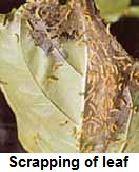 Egg: Eggs are laid in clusters of 50-100, on the lower side of leaves.
Egg: Eggs are laid in clusters of 50-100, on the lower side of leaves.- Larva: The larvae are covered with long yellowish to black hairs and are up to 5 cm long.
- Pupa: Pupation takes place in the soil under dry.
- Adult: The adult is a brown moth with a 40-50 mm wing span and a red abdomen.
- Young larvae feed gregariously mostly on the under surface of the leaves.
- Caterpillars feed on leaves and in severe infestation the whole crop is defoliated.
Mustard aphid
Biology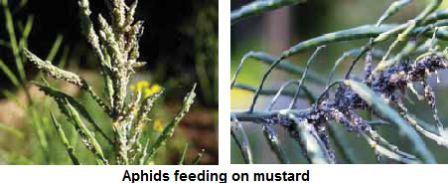 Egg: Eggs are white in colour and laid along the veins of leaves.
Egg: Eggs are white in colour and laid along the veins of leaves.- Nymph: There are four nymphal stages (instars). The general appearance of each stage is similar except for increase in size during subsequent instars. The first, second, third and fourth nymphal stages last 1-2, 2, 2, and 3 days respectfully.
- Adult: Aphids are small, soft-bodied, pear-shaped insects that have a pair of cornicles (wax-secreting tubes) projecting out from the fifth or sixth abdominal segment. Wingless, female, aphids are yellowish green, gray green or olive green with a white waxy bloom covering the body. The winged, female, adult aphids have a dusky green abdomen with dark lateral stripes separating the body segments and dusky wing veins. Male aphids are olive green to brown in color. The aphid attacks generally during 2nd and 3rd week of December and continues till March.
- Both nymph and adults suck the sap from leaves, buds and pods.
- Curling may occur for infested leaves and at advanced stage plants may wither and die.
- Plants remain stunted and sooty molds grow on the honey dew excreted by the insects.
Painted bug
Biology Egg: Painted bug lays its eggs in clusters on leaves or on the soil underneath host plants. Eggs are barrel shaped, initially white and turn orange with age. A single female can lay as many as 100 eggs within 2 to 3 weeks. The incubation period is 5 to 8 days
Egg: Painted bug lays its eggs in clusters on leaves or on the soil underneath host plants. Eggs are barrel shaped, initially white and turn orange with age. A single female can lay as many as 100 eggs within 2 to 3 weeks. The incubation period is 5 to 8 days- Nymph: Nymph pass through five stages changing colour from bright orange to red with dark markings, gradually acquiring the colouration of the adult. Initially they do not have wings; wings are gradually developed as the nymphs grow. Wing pads are visible in the last instar nymph.
- Adult: The adult bug is typically shield-shaped, 5 to 7 mm long and 3 to 4 mm broad at its widest area. The upper surface has a mixture of black, white and orange markings, which gives the insect its common names harlequin bug or painted bug. The life cycle lasts 3 to 4 weeks and several generations may occur in a year. Period of activity of painted bug starts from September.
- Adults and nymphs suck sap from all parts of the plant.
- Young plants wilt and wither as a result of the attack.
- Adult bugs excrete a resinous substance which spoils the pods.
- Quality and quantity (31% losses) of yield is affected when grown up plants are infected.
- Harvested crop in threshing floor is also infested.
Mustard saw fly
Biology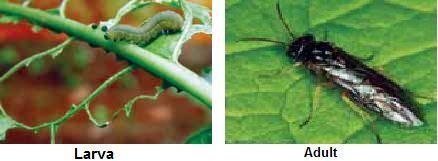 Egg: Eggs are spherical, about 0.5 mm in diameter, light bluish green in colour.
Egg: Eggs are spherical, about 0.5 mm in diameter, light bluish green in colour.- Larva: Larva is greenish black with wrinkled body and eight pairs of pro-legs. On slightest touch the larva falls to round and feigns death. The larvae had 6 instars, fed on the leaves, and pupated after 14-16 days.
- Pupa: Pupae are look like sand particle and have salivary secretions; the pupal stage lasted 11-12 days.
- Adult: Adults are orange bodied with smoky transparent wings. The pest is active during seedling stage of the crop i.e. October - November.
- Initially the larva nibbles leaves, later it feeds from the margins towards the midrib.
- The grubs cause numerous shot holes and even riddled the entire leaves by voracious feeding.
- They devour the epidermis of the shoot, resulting in drying up of seedlings and failure to bear seeds in older plants.
- The yield losses up to 5 to 18 %. In severe case at the seedling stage, the crops have to be re sown.
Mustard leaf miner
Biology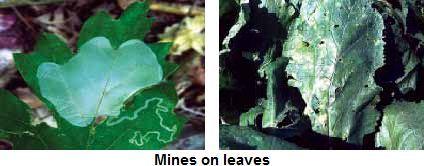 Mine linear, whitish, both upper and lower surface. Pupation internal, at the end of the mine with the anterior spiracles projecting through the epidermis.
Mine linear, whitish, both upper and lower surface. Pupation internal, at the end of the mine with the anterior spiracles projecting through the epidermis.- Upper-surface, less often lower-surface corridor, Pupation within the mine and soil; pupal chamber in a, usually lower-surface.
- A long whitish upper surface corridor, which eventually goes lower surface
- Leaves with mines; the attacked leaves wither; vigour of the plant gets reduced. Its damage is often more prominent on the older leaves
Diamondback moth
Biology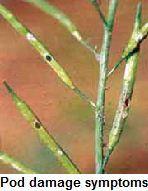 Egg: Minute yellow coloured eggs. Eggs laid singly or in groups – upper surface of leaves. Egg hatches in about 7 days.
Egg: Minute yellow coloured eggs. Eggs laid singly or in groups – upper surface of leaves. Egg hatches in about 7 days.- Larva: Pale yellowish green caterpillar. Larval period is 14 days
- Pupa: Pupation takes place on the foliage in a transparent cocoon. Pupal period is about 7 days.
- Adult: Small greyish brown moth with three white triangular spots along the inner-margin which give diamond shape at rest position. Hind wings with fringe of long fine hairs
- Caterpillars feed on the foliage.
- The leaves give a withered appearance but in later stages larvae bore holes in the leaves may be eaten up completely.
- It also bores into pods and feeds developing seed.
Cabbage head borer
Biology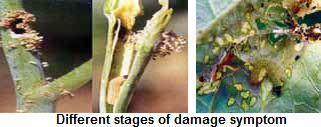 Egg: Female moth lays yellowish shiny eggs on leaves. Eggs hatch in about 4 days.
Egg: Female moth lays yellowish shiny eggs on leaves. Eggs hatch in about 4 days.- Larva: The caterpillar becomes full grown in about 9 days. Full grown caterpillar is 12-15 mm, greyish yellow with seven purplish brown longitudinal stripes on the body
- Pupa: Full grown larva pupates in the larval burrow itself or in the soil. Pupal period is about 6 days.
- Adult: Adult is pale yellowish-brown moth having grey wavy lines on the forewing.
- Caterpillars initially mine the leaves and make it white papery.
- Later they feed on leaves and bore into stems entrance hole is covered with silk and excreta.
Larger moth (leaf Webber)
Biology Egg: Female moth lays eggs in masses of 40 -100 on underside of leaves. They hatch in 5 -15 days.
Egg: Female moth lays eggs in masses of 40 -100 on underside of leaves. They hatch in 5 -15 days.- Larva: Caterpillar webs together the foliage and feeds on leaves. It also feeds on flowers and pods in the case of mustard and flower heads in cabbage and cauliflower. Caterpillar bears red head with brown longitudinal stripes and rows of tubercles on the body. Larval period is 24-27 days.
- Pupa: Pupation takes place in a cocoon within the webbed leaves. Pupal period is 14-40 days.
- Adult: Adult is small with light brownish forewings.
- Newly hatched larvae feed initially on the chlorophyll of young leaves and later on older leaves, buds and pods, make webbings and live within.
- Severely attacked plants are defoliated.
- Seeds in the pods are eaten away.
IPM for Mustard
To know the IPM practices for Mustard, click here.
Source: NIPHM and Directorate of Plant Protection, Quarantine & Storage
Last Modified : 11/20/2020
© C–DAC.All content appearing on the vikaspedia portal is through collaborative effort of vikaspedia and its partners.We encourage you to use and share the content in a respectful and fair manner. Please leave all source links intact and adhere to applicable copyright and intellectual property guidelines and laws.
RELATED ITEMS
Common Insect Pests of Crucifer Crops and their management
This article provides an overview of seven common ...
Mustard: Natural Enemies
Natural enemies of Mustard/Rapeseed insect pests a...
Cabbage and Cauliflower Insect pests
This topic covers information about Cabbage and Ca...
Broccoli Insect Pests
This topic covers information about Broccoli Ins...
